Functions of HRM for Workforce Planning and Resourcing
21 Pages5718 Words58 Views
Added on 2023-01-19
About This Document
This document explains the purpose and functions of HRM in the context of workforce planning and resourcing an organization. It discusses the strengths and weaknesses of different approaches to recruitment and selection. The document also provides insights into the benefits of HRM practices within an organization and the importance of employee relations in influencing HRM decision-making.
Functions of HRM for Workforce Planning and Resourcing
Added on 2023-01-19
ShareRelated Documents
HUMAN RESOURCE MANAGEMENT
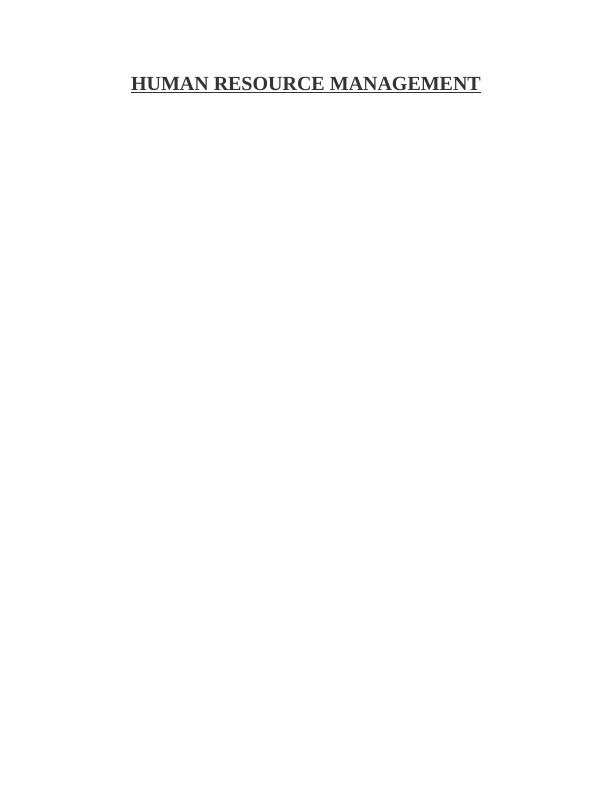
Table of Contents
INTRODUCTION...........................................................................................................................3
MAIN BODY...................................................................................................................................3
P1 Explain the purpose and the functions of HRM, applicable to workforce planning and
resourcing an organisation...........................................................................................................3
P2 Explain the strengths and weaknesses of different approaches to recruitment and selection.
......................................................................................................................................................5
P3 Explain the benefits of different HRM practices within an organisation for both the
employer and employee...............................................................................................................6
B) Flexible working arrangements for staff offered by Microsoft along with its benefits to
employer and employee :.............................................................................................................7
P4 Evaluate the effectiveness of different HRM practices in terms of raising organisational
profit and productivity.................................................................................................................7
P5 Analyse the importance of employee relations in respect to influencing HRM decision-
making. ........................................................................................................................................7
P6 Identify the key elements of employment legislation and the impact it has upon HRM
decision- making..........................................................................................................................8
P7 Illustrate the application of HRM practices in a work related context, using specific
examples......................................................................................................................................9
A) Person specification for the role of receptionist.....................................................................9
CONCLUSION..............................................................................................................................10
REFERENCES..............................................................................................................................11
INTRODUCTION...........................................................................................................................3
MAIN BODY...................................................................................................................................3
P1 Explain the purpose and the functions of HRM, applicable to workforce planning and
resourcing an organisation...........................................................................................................3
P2 Explain the strengths and weaknesses of different approaches to recruitment and selection.
......................................................................................................................................................5
P3 Explain the benefits of different HRM practices within an organisation for both the
employer and employee...............................................................................................................6
B) Flexible working arrangements for staff offered by Microsoft along with its benefits to
employer and employee :.............................................................................................................7
P4 Evaluate the effectiveness of different HRM practices in terms of raising organisational
profit and productivity.................................................................................................................7
P5 Analyse the importance of employee relations in respect to influencing HRM decision-
making. ........................................................................................................................................7
P6 Identify the key elements of employment legislation and the impact it has upon HRM
decision- making..........................................................................................................................8
P7 Illustrate the application of HRM practices in a work related context, using specific
examples......................................................................................................................................9
A) Person specification for the role of receptionist.....................................................................9
CONCLUSION..............................................................................................................................10
REFERENCES..............................................................................................................................11

INTRODUCTION
Human Resource Management (HRM) is the practice of recruiting, hiring, deploying and
managing an organisation's employees so that their performance can be made efficient and the
goals and objectives of an organisation can be achieved. It includes development and training,
resolving of conflicts, maintaining effective communication etc. in the organisation (What is
Human Resource? 2019). 'Unilever' is a company multinational consumer goods company that
provides fast moving consumer goods. Its product categories include savoury, dressings and
spread; ice cream and beverages; personal care, and home care.
The following report will cover various functions and purpose of HRM for workforce
planning, strengths and weaknesses of approaches of selection and the improvements that can be
made to enhance the selection process. Unilever is a British-Dutch transnational consumer
goods company co-headquartered in London, United Kingdom, and Rotterdam, Netherlands. Its
products include food and beverages (about 40 percent of its revenue), cleaning agents, beauty
products, and personal care products HRM practices at Unilever are such that they encourage
personal growth and development and opportunities whilst providing a range of benefits and
rewards to its employees. Some of its HRM practices are also discussed in this report which
gives a wide understanding about the increasing profits and productivity of the company on such
a wide scale.
MAIN BODY.
P1 Explain the purpose and the functions of HRM, applicable to workforce planning and
resourcing an organisation.
Human Resource management is concerned with hiring, motivating and maintaining workforce
within an organisation (Albrecht and et. al., 2015). HRM is all about acquiring services of
people, developing their skills, motivating them to the foremost level and making sure that they
continue to maintain their commitment towards the organisation. Additionally, it helps the
organisation in obtaining right number and type of employees, develop organisational culture,
maintain performance standards increase productivity create a healthy and safe work culture.
Employees are internal sources of competitive advantage to achieve the organisational
objectives. Some of the major functions of HRM in the context of 'Unilever' are as follows: Survival: In order to survive in the market Unilever must be engaged in providing
effective training to employees so that the firms efficiency can be improved.
Human Resource Management (HRM) is the practice of recruiting, hiring, deploying and
managing an organisation's employees so that their performance can be made efficient and the
goals and objectives of an organisation can be achieved. It includes development and training,
resolving of conflicts, maintaining effective communication etc. in the organisation (What is
Human Resource? 2019). 'Unilever' is a company multinational consumer goods company that
provides fast moving consumer goods. Its product categories include savoury, dressings and
spread; ice cream and beverages; personal care, and home care.
The following report will cover various functions and purpose of HRM for workforce
planning, strengths and weaknesses of approaches of selection and the improvements that can be
made to enhance the selection process. Unilever is a British-Dutch transnational consumer
goods company co-headquartered in London, United Kingdom, and Rotterdam, Netherlands. Its
products include food and beverages (about 40 percent of its revenue), cleaning agents, beauty
products, and personal care products HRM practices at Unilever are such that they encourage
personal growth and development and opportunities whilst providing a range of benefits and
rewards to its employees. Some of its HRM practices are also discussed in this report which
gives a wide understanding about the increasing profits and productivity of the company on such
a wide scale.
MAIN BODY.
P1 Explain the purpose and the functions of HRM, applicable to workforce planning and
resourcing an organisation.
Human Resource management is concerned with hiring, motivating and maintaining workforce
within an organisation (Albrecht and et. al., 2015). HRM is all about acquiring services of
people, developing their skills, motivating them to the foremost level and making sure that they
continue to maintain their commitment towards the organisation. Additionally, it helps the
organisation in obtaining right number and type of employees, develop organisational culture,
maintain performance standards increase productivity create a healthy and safe work culture.
Employees are internal sources of competitive advantage to achieve the organisational
objectives. Some of the major functions of HRM in the context of 'Unilever' are as follows: Survival: In order to survive in the market Unilever must be engaged in providing
effective training to employees so that the firms efficiency can be improved.
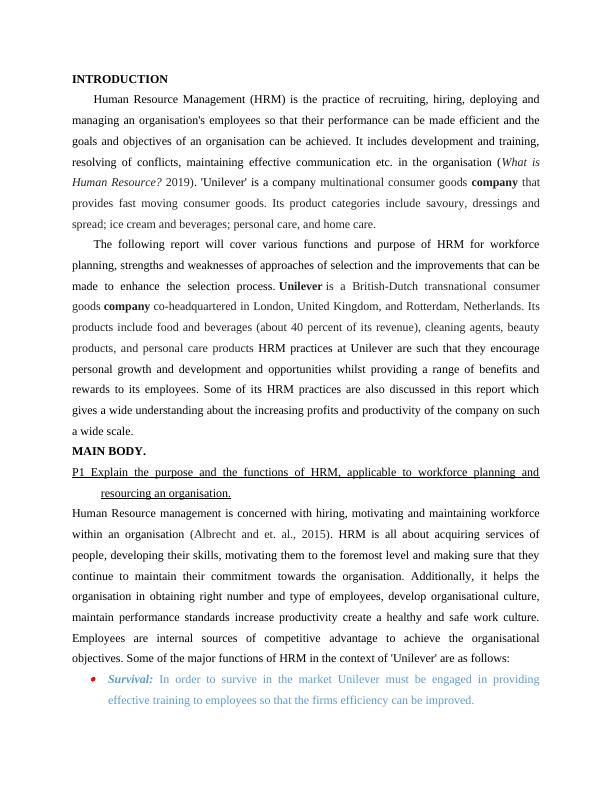
Increasing sales- Unilever can increase the sale of the products by providing consumers
with high quality of products. For this the company needs to be involve in recruiting and
selecting efficient staff, so that the productivity of firm can be increased. Increasing profit- Profit in the company can only be achieved if the job design made by
them is appropriate. Every employee in Unilever must be placed at the positions which
are according to their skills and talent. This will support firm in increasing their profit.
Increasing growth: In order to grow, Unilever must be engaging in providing efficient
training to workers, so that their goals and objectives can be achieved.
Recruitment and selection: It is a process which brings pool of prospective candidates
who can help organisation achieve their goals and allows management to select right
candidates depending on the needs of the organisation. The criteria used by 'Unilever' for
recruitment and selection is through assessment test and interview. This helps the
organisation in short-listing the candidates who have applied for production or
administration vacancies. The purpose of this function is to select appropriate employees
for a job vacancy who can contribute maximum efforts with their skills and knowledge. It
will increase the possibilities of achieving organisational goals and objectives within pre-
determined time period (Cascio, 2015).
Training and development: The employees need to be trained so that their skills can be
used in a better way for achieving the goals and objectives of the organisation. This
function allows employees to acquire new skills and knowledge to perform their job
effectively. It also prepares employees for higher level responsibilities. 'Unilever'
provides on the job training to the workers so that they can acquire skills required for
making variety of chocolate flavours and tailored chocolate based greeting cards and
presents. The purpose of this function is to train employees to perform job specific work
and improve their productivity.
Performance Management: This is a method used by the managers to measure job
performance, maintain productive work groups and identify appropriate workforce for
meeting company's performance standards. Quality of the workforce has to be managed
so that organisation can continue to grow and develop. This function can help 'Unilever'
in monitoring the performance of employees and keep a check on their activities so that
the products offered by the company are of desired quality. The purpose of this function
with high quality of products. For this the company needs to be involve in recruiting and
selecting efficient staff, so that the productivity of firm can be increased. Increasing profit- Profit in the company can only be achieved if the job design made by
them is appropriate. Every employee in Unilever must be placed at the positions which
are according to their skills and talent. This will support firm in increasing their profit.
Increasing growth: In order to grow, Unilever must be engaging in providing efficient
training to workers, so that their goals and objectives can be achieved.
Recruitment and selection: It is a process which brings pool of prospective candidates
who can help organisation achieve their goals and allows management to select right
candidates depending on the needs of the organisation. The criteria used by 'Unilever' for
recruitment and selection is through assessment test and interview. This helps the
organisation in short-listing the candidates who have applied for production or
administration vacancies. The purpose of this function is to select appropriate employees
for a job vacancy who can contribute maximum efforts with their skills and knowledge. It
will increase the possibilities of achieving organisational goals and objectives within pre-
determined time period (Cascio, 2015).
Training and development: The employees need to be trained so that their skills can be
used in a better way for achieving the goals and objectives of the organisation. This
function allows employees to acquire new skills and knowledge to perform their job
effectively. It also prepares employees for higher level responsibilities. 'Unilever'
provides on the job training to the workers so that they can acquire skills required for
making variety of chocolate flavours and tailored chocolate based greeting cards and
presents. The purpose of this function is to train employees to perform job specific work
and improve their productivity.
Performance Management: This is a method used by the managers to measure job
performance, maintain productive work groups and identify appropriate workforce for
meeting company's performance standards. Quality of the workforce has to be managed
so that organisation can continue to grow and develop. This function can help 'Unilever'
in monitoring the performance of employees and keep a check on their activities so that
the products offered by the company are of desired quality. The purpose of this function
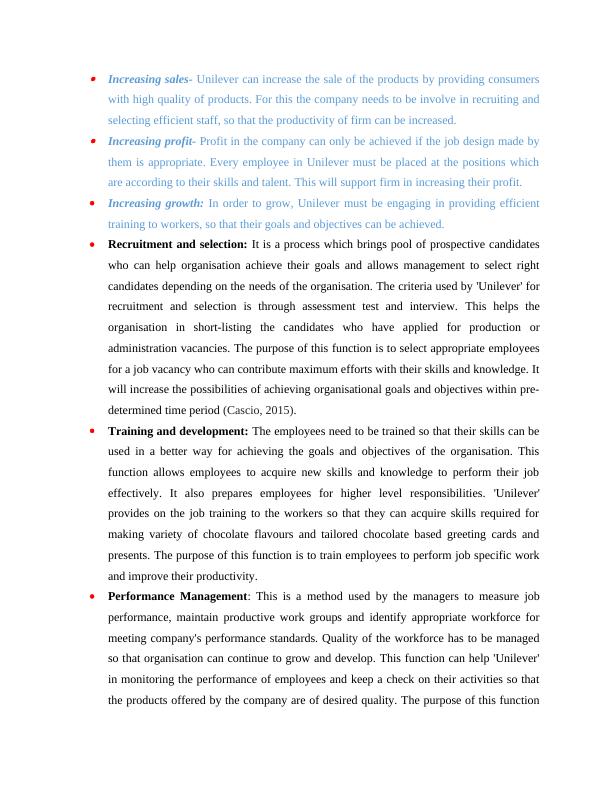
is to evaluate the performance of the employees and work towards improving their
efficiency (Cascio, 2015).
Compensation and Benefit: HRM helps in determining pays for different job types,
managing personnel expenses budgets, setting performance standards, providing
transparent compensation policies and giving extra benefits to the employees based on
their performance. This gives job satisfaction and motivation to the employees to work
more efficiently. This function can help Unilever to reduce employee turnover as they
will be compensated based on their performance the purpose of this function is to
encourage employee engagement and increase their retention in the organisation.
HRM practices at Unilever are such that they encourage personal growth and
development and opportunities whilst providing a range of benefits and rewards to its
employees. Some of its HRM practices are also discussed in this report which gives a
wide understanding about the increasing profits and productivity of the company on such
a wide scale.
M1 Determine and explain the Human resource functions to fulfil business goals and objectives.
In Unilever, an effective human resource can provide with overall structure and ability to
achieve business goals. It always tries to perform different function that have set of practices
which defined the nature of regulation in job relationships.
It is developing the organizational climate which help for encouraged employee towards
business process and doing work efficiently.
Human resource manager is helping for maintaining performance and productivity of
business by providing training, design job as per need, taking feedback on basis of
performance.
These are helpful for Unilever firm that can easily achieve the business goal for increasing
productivity and profitability in marketplace.
HRM Models:
Hard Human resource management: It is considered as a model that identify different
resources for organization to achieve their goals and objectives. it mainly focused on the
Hard HRM where it has selected the right candidates, who are talented and acquire all
type of knowledge.
efficiency (Cascio, 2015).
Compensation and Benefit: HRM helps in determining pays for different job types,
managing personnel expenses budgets, setting performance standards, providing
transparent compensation policies and giving extra benefits to the employees based on
their performance. This gives job satisfaction and motivation to the employees to work
more efficiently. This function can help Unilever to reduce employee turnover as they
will be compensated based on their performance the purpose of this function is to
encourage employee engagement and increase their retention in the organisation.
HRM practices at Unilever are such that they encourage personal growth and
development and opportunities whilst providing a range of benefits and rewards to its
employees. Some of its HRM practices are also discussed in this report which gives a
wide understanding about the increasing profits and productivity of the company on such
a wide scale.
M1 Determine and explain the Human resource functions to fulfil business goals and objectives.
In Unilever, an effective human resource can provide with overall structure and ability to
achieve business goals. It always tries to perform different function that have set of practices
which defined the nature of regulation in job relationships.
It is developing the organizational climate which help for encouraged employee towards
business process and doing work efficiently.
Human resource manager is helping for maintaining performance and productivity of
business by providing training, design job as per need, taking feedback on basis of
performance.
These are helpful for Unilever firm that can easily achieve the business goal for increasing
productivity and profitability in marketplace.
HRM Models:
Hard Human resource management: It is considered as a model that identify different
resources for organization to achieve their goals and objectives. it mainly focused on the
Hard HRM where it has selected the right candidates, who are talented and acquire all
type of knowledge.
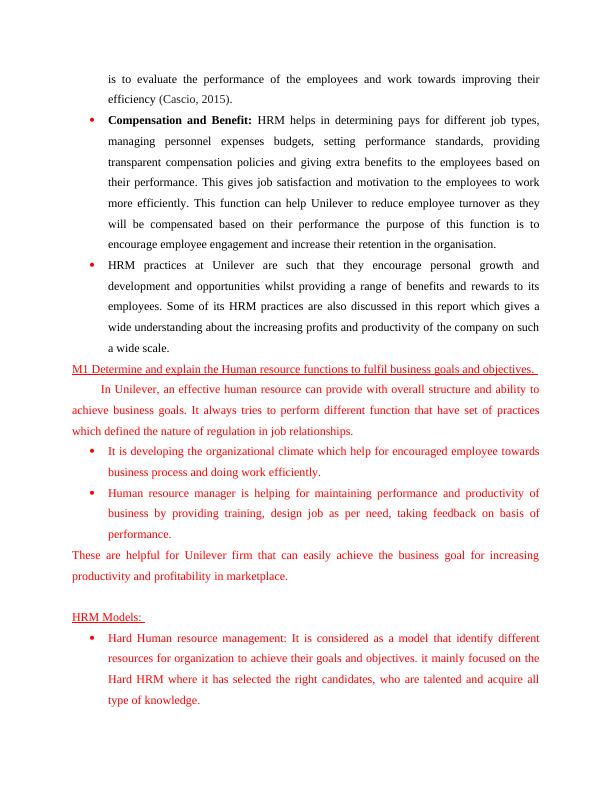
Soft human resource management: it is important practices within organization that
always focused on valuable assets and must ensure that fulfil need or requirement of staff
members. in this way, it also satisfied customers demands. On the other hand, there are
many employees focused on essential resources which make it possible for achieve
business goals and objectives. For Example- Unilever provide insurance facilities to their
staff members and also recommended to use soft HRM for achieving business goals and
objectives.
P2 Explain the strengths and weaknesses of different approaches to recruitment and selection.
Internal recruitment process through which the company is having the recruitment of the
employee from the whingeing the business to have the proper recruitment of the employees from
the existing workforce which is been identified as the primary sources for company proper
implementation of the recruitment process. The company is having the benefit is proper analysis
of having reduction in expenses in hiring the employee along with have the promotion of
employer engagement which have results in flexible nature of employee in longer productivity.
On the other hand, the company is facing the disadvantage as there is limited understanding of
company with having the higher risk. This also have the development of conflicts in the existing
employee which can be because of the jealousy or post rearrested query in longer term
productivity.
Advantages
Boost retention: This builds a culture of trust and increases engagement with encouraging
the employees to remain in the company.
Hire quicker: The employee's performance and track records can help the managers in
evaluating the worthiness of the candidate thus speeding up the recruitment process.
Saves money: Hiring internally saves costs of recruitment like advertising, payment to
hiring agencies etc.
Boost retention is most important and influential strength as this can support Unilever in creating
employee loyalty and reducing the worker’s turnover. This can support organization in creating
goodwill in society.
Disadvantage
always focused on valuable assets and must ensure that fulfil need or requirement of staff
members. in this way, it also satisfied customers demands. On the other hand, there are
many employees focused on essential resources which make it possible for achieve
business goals and objectives. For Example- Unilever provide insurance facilities to their
staff members and also recommended to use soft HRM for achieving business goals and
objectives.
P2 Explain the strengths and weaknesses of different approaches to recruitment and selection.
Internal recruitment process through which the company is having the recruitment of the
employee from the whingeing the business to have the proper recruitment of the employees from
the existing workforce which is been identified as the primary sources for company proper
implementation of the recruitment process. The company is having the benefit is proper analysis
of having reduction in expenses in hiring the employee along with have the promotion of
employer engagement which have results in flexible nature of employee in longer productivity.
On the other hand, the company is facing the disadvantage as there is limited understanding of
company with having the higher risk. This also have the development of conflicts in the existing
employee which can be because of the jealousy or post rearrested query in longer term
productivity.
Advantages
Boost retention: This builds a culture of trust and increases engagement with encouraging
the employees to remain in the company.
Hire quicker: The employee's performance and track records can help the managers in
evaluating the worthiness of the candidate thus speeding up the recruitment process.
Saves money: Hiring internally saves costs of recruitment like advertising, payment to
hiring agencies etc.
Boost retention is most important and influential strength as this can support Unilever in creating
employee loyalty and reducing the worker’s turnover. This can support organization in creating
goodwill in society.
Disadvantage
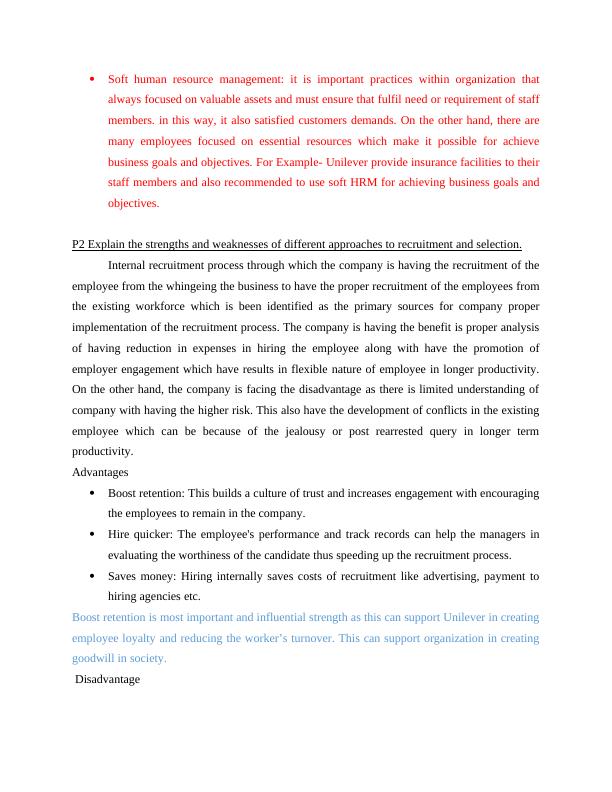
End of preview
Want to access all the pages? Upload your documents or become a member.
Related Documents
Benefits of HRM Practices for Employer and Employeelg...
|20
|5277
|53
Purpose and the Scope of Human Resource Management - Doclg...
|13
|4119
|99
Assignment - Human Resource Management (doc)lg...
|17
|4363
|334
Benefits of HRM Practices for Organizational Profit and Productivitylg...
|16
|4698
|69
Employee Induction Manual: Functions and Practices of HRM in Unileverlg...
|15
|4824
|3
HUMAN RESOURCE MANAGEMENT INTRODUCTION 3 P1) THEORIES OF H.R.Mlg...
|16
|3965
|111
